Touched by a Shark
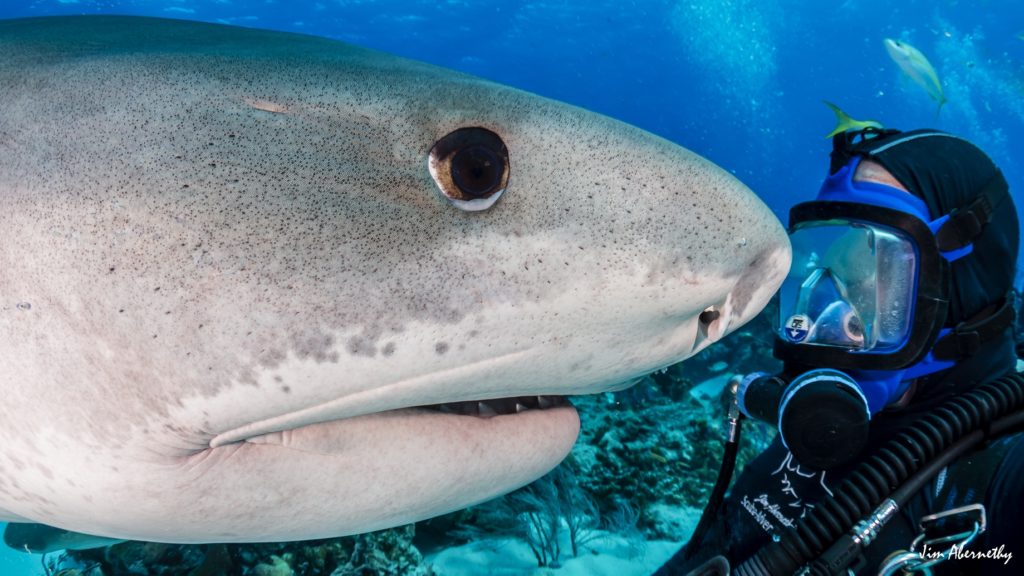
For a couple years as a kid I lived on the island of Key West, a bohemian U.S. outlier ninety miles north of Cuba. Key West by that time had become a sportfishing mecca, and come five o’clock a boy with time and no money could entertain himself by walking the docks as the charter fleet returned with their catch of the day, and be endlessly amazed by the monsters.
The great barracudas hung like dagger-toothed torpedoes, the goliath groupers like giant marine boar. I would ogle them all, but it was the sharks that hypnotized. Reef sharks, tiger sharks, great hammerhead sharks—I stood staring up at these enormous beasts, their gaping jaws studded with ivory arrowheads, their scythe tails scraping the ground at my feet. I’d stare into the alien eyes of the hammerhead, peering so eerily from the wings of its spaceship head. Up and down the pier I’d wander these macabre gallows of underworld giants. The sea was obviously, endlessly full of them for the taking.
Thirty-some years later I had occasion to visit Key West again, and to tour the boardwalk of charter boat alley. But whatever rose-glow of nostalgia I might have anticipated, was crushed amid the ensuing scene of ruins. Nailed to the display boards were paltry specimens of snapper and jack and baby grouper you could hold in one hand. Here and there was a shark so small, so decidedly underwhelming, I wondered whether a trick of childhood memory had concocted my monsters out of minnows.
But no. Turns out there were photographic archives of these same docks that even then were being pored over by a marine biology student named Loren McClenachan, who would later confirm in graphic detail the disappearances I’d witnessed. The average size of shark hoisted upon the Key West docks had shrunk by half; the great predators had all but vanished.
“The myth that large fish exist and that everyone deserves to catch them must be de-bunked if any remnant of the fish of the past are to be preserved,” McClenachan would conclude in her dissertation.
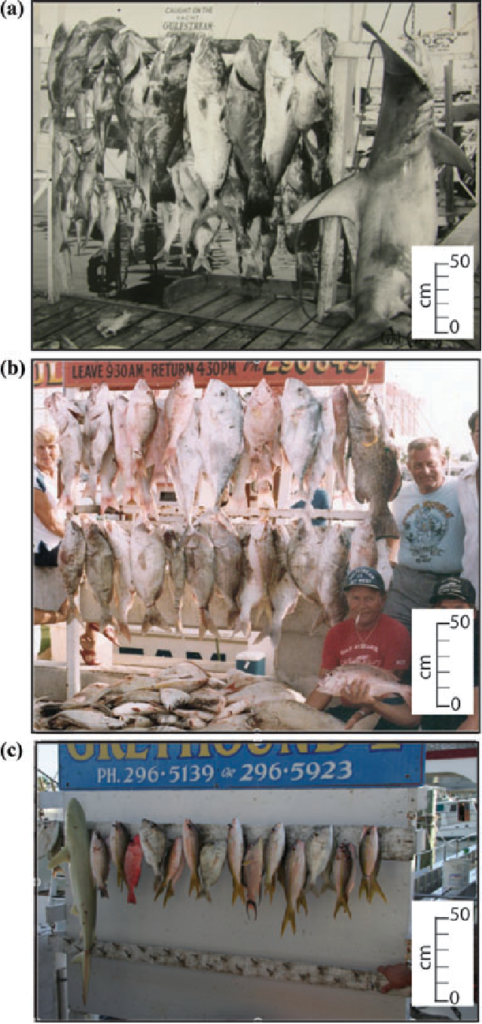
Trophy fish over time — ©Monroe County Public Library (top and center) and Loren McClenachan (bottom)
The Great Downsizing
Key West is no outlier in that respect. Fishing fleets of the world—from the Gulf of Mexico through the Caribbean, across the tropical Pacific, the Mediterranean, and the northwest Atlantic, from coastal reefs to the deep blue abyss—have been scouring the seas ever harder and coming back ever lighter for lack of giants, the populations of great sharks nosediving by as much as 99 percent over the past fifty years. And just this summer came the most comprehensively dispiriting record yet of the ongoing eradications—some eight hundred scientists and volunteers, watching reefs in 58 countries with five thousand remote video cameras—reporting sharks missing from one out of every five reefs surveyed.
There’s no mystery as to why the monsters of yesterday have vanished. These are animals who are slow to grow and reproduce, relentlessly pursued and outpaced by a high-tech global armada slaughtering them for food, fins, and fun. Their demise is the simple math of too many hooks and nets and too little restraint and compassion in a crowded, insatiable world.
Well, so what?
Until lately I might have answered with the standard conservation script, reciting how painfully we’ll all miss the sharks’ ecological powers and economic assets. I would have touted the big sharks’ roles as apex predators—as winnowers of the weak, custodians of the reef, as balancing rods of marine life. Or I might have extolled their commercial clout, about how a wild shark can draw a thousand times more money in a year as a tourist attractant than as a one-off slab of meat or soup thickener for high society.
But these days those pragmatic arguments ring hollow as I try to square my own misgivings about that lonesome walk down fisherman’s lane. These days I’m haunted by the missing faces of those giants who once hung from the docks, by the distant gaze of the hammerhead.
So I find myself playing reporter again, scouring the scientific literature, calling on the experts, ostensibly in search of yet another newsworthy angle on yet another grim report on the state of our sharks. But what I’m really searching for, in such demoralizing days as these, are stories of hope and encouragement, and kindred souls who would bring those missing faces back….
And there they are. A scuba guide in the Bahamas named Jim Abernethy, who transforms his clients into shark defenders with the help of a 15-foot tiger shark who likes to have her snout rubbed. The fearless young activist Madison Stewart from the Great Barrier Reef of Australia who trades her high school tuition for an underwater camera and becomes Shark Girl, traveling the world to expose the sordid realities of the shark fin industry. Tova Bornovski, a Floridian ex-pat who thirty years ago sailed across the Pacific to the archipelago of Palau, fell in love with its people and sharks, and has since become a leading voice for the largest shark sanctuary in the world.
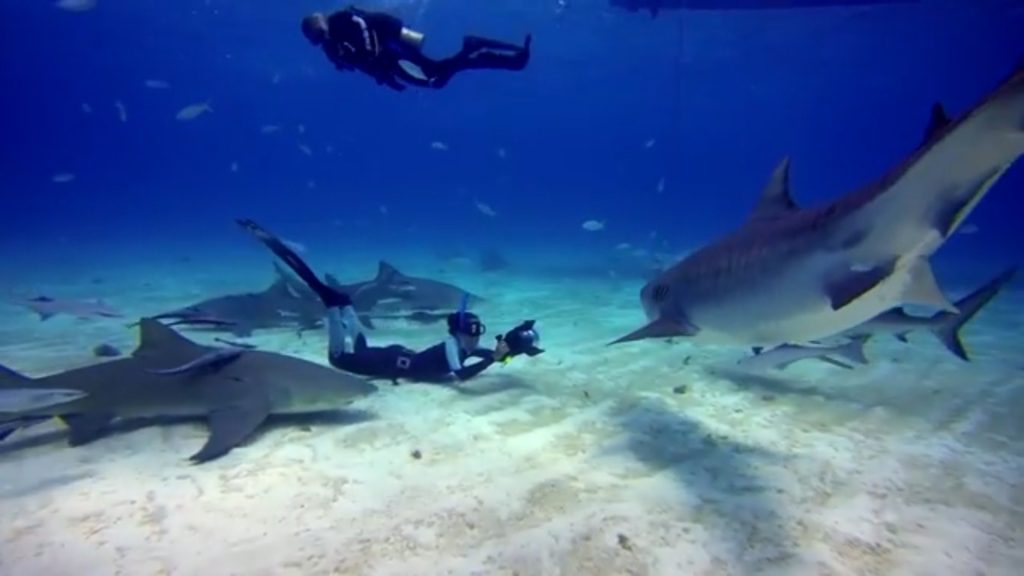
Shark Girl Madi Stewart in her element. — ©Bluethefilm.org
On and on I could go. And I don’t even need to go far. My new home du jour is the southwest coast of Florida, where I find myself surrounded by a virtual sea of shark champions. Just ten miles west as the pelican flies lies Sanibel Island, home to an ecologically enlightened citizenry and headquarters for the Sanibel-Captiva Conservation Foundation. SCCF, besides setting aside critical tracts of native habitat and monitoring all forms of wildlife on the sister islands of Sanibel and Captiva, has recently gone big on shark conservation, with an online clearinghouse for budding activists and a new executive director, Ryan Orgera, who has traveled the world campaigning for sharks. Just up the coast in Sarasota is the Mote Marine Laboratory’s Center for Shark Research. And across the peninsula I find the University of Miami and Florida International University, two of the world’s most productive hubs of shark science, their academic rosters and research teams stacked with all-stars in the world of shark conservation.
The defenders come from all angles, their passions all moored to the same charismatic fish that enchants like no other. And terrifies further still. The shark is the fish that in 1975 launched Jaws, the original summer blockbuster, in which a malevolent, supersized man-eater terrorizes a New England resort town. Jaws would poison the American psyche with an irrational fear of sharks, sending lynch mobs of fishermen out to avenge the monster’s imaginary crimes. It’s an enduring mania commonly called the “Jaws” effect. It’s an attitude that the sharks’ defenders are fighting tooth and fin, and slowly winning.
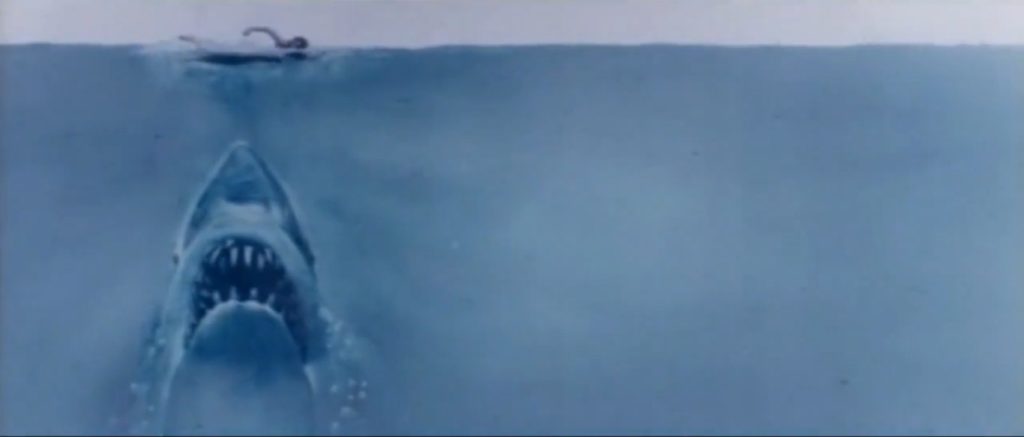
Jaws–the Hollywood version
Rounding up the Wranglers
The barrier island Sanibel is like few other developed islands on the Atlantic-Gulf chain. Its beaches are still wild, its dunes and mangroves and maritime forests largely intact. It seas are teeming with sea life, and therefore a rather uncommon abundance of big sharks. Tiger sharks and bull sharks—and even the rare hammerhead shark—are relatively thick in Sanibel waters.
Sanibel has thus become famous for its shark fishing. Or should we say, for its selfie-enamored shark fishers. It has attracted a certain sort who angles more for Instagram followers and YouTube likes. We know them from their own photos and video, proudly and repeatedly documenting themselves torturing sharks on camera, breaking every ethical and legal code of shark fishing. We see shirtless dudes in epic hook-and-rod struggles, gallantly fighting monster sharks to their exhaustion, hauling them out over rough ground, squatting upon their backs, crushing internal organs, kicking sand in their gills and leisurely taking measurements and selfies as they suffocate. Thus congratulating themselves, they drag their beaten quarry back out to release with a perverse nod to conservation, mindless of how many will soon be sinking belly-up to the bottom.
But there have come to be even badder predators atop the Sanibel food chain, bearing the plainer field marks of bespectacled, tan-free, shirt-wearing shark scientists. Among them, David Shiffman and Neil Hammerschlag, alumnus and director, respectively, of the University of Miami’s Shark Research and Conservation Program, have been trolling among the shark wranglers’ Instagram lairs and Facebook hangouts, exposing their crimes and cruelties to the glare of academic journals and mass media and those who enforce the law.
Last year, when Florida’s wildlife commissioners issued a stricter and more compassionate set of rules for the state’s shark fishers, they echoed corrections the scientists had explicitly proposed.
What a Shark Knows
But back to Jaws. As much as the movie has wrecked the shark’s reputation in so many irreparable ways, so too has it inspired a generation of wide-eyed kids into becoming the sharks’ most ardent defenders.
“Every shark biologist of my age and younger saw Jaws and wanted to be [the movie’s marine biologist] Matt Hooper,” says Demian Chapman of Florida International University, who went on to orchestrate the global network of reef cams that recently alerted the world to their sharks’ stunning declines. “We all wanted to be shark biologists.”
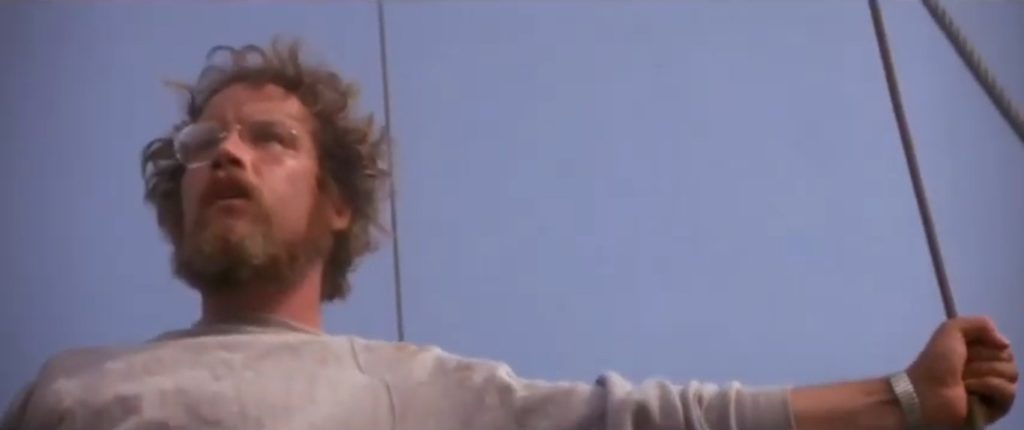
Matt Hooper, fictional shark god
Even the Shark Girl, Madi Stewart, who was born nearly twenty years after Jaws premiered, has embraced the movie’s kinder spirit, through her new non-profit called The Hooper Collective. “Hooper was the one guy that didn’t want them to kill the shark,” says Stewart, now in her late twenties. “I want more people to be like Hooper.” The Hooper Collective helps fund Stewart’s ongoing investigations and exposés—of the factors behind shark attacks (spoiler alert: it’s largely our fault); the dangers of eating shark meat (laden with mercury); and the moral bankruptcy of the shark fin industry (brutal slaughter that the poorest are made to carry out, for a treacly soup that nobody needs and only the rich can afford).
Every shark champion has a familiar childhood story, of that moment when the powerful grace and humbling presence of that special fish captured them forever.
“You could describe the shark as the lord of time,” said the late Sonny Gruber, one of the grand pioneers of shark science, “a fish that has been around for half a billion years. You have an animal that is as highly evolved in that side of the world as a human is in this side of the world.”
Neurobiologists and animal behaviorists have begun to unwrap the mind inside that supernatural presence—a rather deft and complex mind that shares far more with ours than any alien’s should. It is a mind that quite likely feels pain and fear and suffering. It is a mind that knows contentment and, dare we say, happiness—emotions that serious scientists were once loathe to admit.
“They are not just things,” writes the animal behaviorist, Jonathan Balcombe, author of the book What a Fish Knows. “They are sentient beings with lives that matter to them.”
We now know that manta rays, the sharks’ enormous, wing-bodied cousins, have the largest brain of any fish. Mantas can actually recognize themselves in mirrors. They parade and primp in front of them, checking themselves out, waving their cephalic fins and blowing bubbles of curiosity—behaviors rarely directed at fellow mantas. They display nothing short of an awareness of themselves, a degree of self-consciousness found in yet a small and select company of intellects that includes dolphins and chimps (but alas, not humans until about 18 months of age).
We’ve more recently learned that the Port Jackson shark can learn to navigate mazes constructed by curious scientists–even faster after watching one of their trained companions do it first. Sharks learn, and copy.
Reeling Us In
And as a growing league of laypeople can attest, some sharks even like to be petted. Years ago, on a Bahama reef called Tiger Beach, the diver Jim Abernethy met a lemon shark suffering one eye missing and a hook through its jaw. “I got this crazy idea,” says Abernethy. “‘I wonder if I can make friends with this shark in the same ways as with a strange dog, giving it affection enough to bond with it so I could get the hook out.’” Within two hours Abernethy did exactly that. “To this day, Captain Ron the shark [named after the salty one-eyed sailor in the 1992 comedy movie of the same title] is still swimming with me.”
Abernethy has since removed hundreds of hooks and befriended individuals from at least eight species of shark. Some of his more regular visitors have become movie stars and social media celebrities, with names like Shredder the nurse shark and Emma the 15-foot tiger shark. Emma for her part has charmed Abernethy and thousands of his diving clients over the last 20 years, through eight pregnancies and four hooks removed by Abernethy. “She’s like this large gentle dog who just wants to play.”
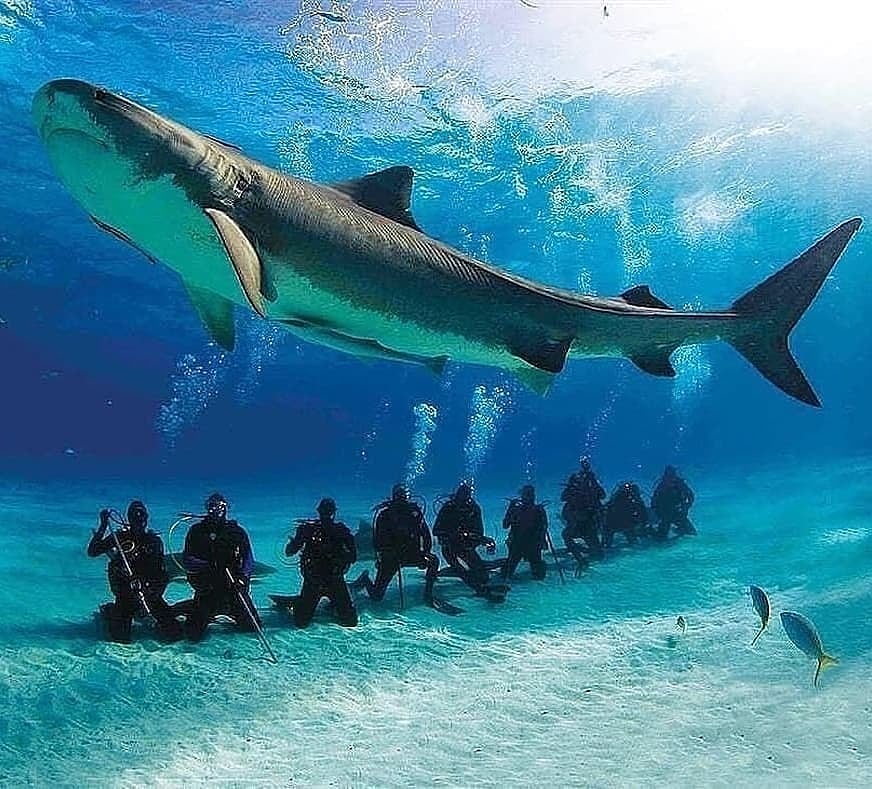
School of shark: Jim Abernethy’s students meet their guest instructor, Emma. ©Jim Abernethy
The visceral appeal of swimming with sharks has become one of the more promising developments in reversing the sharks’ downfall. In the Bahamas, where Abernethy’s boat is joined by fleets of shark-diving boats, the industry brings in $114 million a year. The divers come to play and pay because there are so many big sharks. There are so many big sharks because years ago the Bahamas astutely outlawed shark fishing in its surrounding waters.
It’s a model of profitable benevolence that has been catching on, with more than forty countries and half a million paying tourists diving in for the thrill of an intimate moment with shark. Here and there across the global seas, economies built on shark watching have become lifeboats for seaside communities and their sharks. Big swaths of ocean are being set aside as sanctuaries to accommodate them both. In 2009, the Micronesian archipelago of Palau in the western Pacific became the world’s first national shark sanctuary, ending all commercial shark fishing over a quarter million square miles of surrounding ocean, and bringing shark tourists flocking by the thousands. Palau is where the same grey reef shark once worth a hundred bucks for its meat and fins, is now worth nearly $2 million as a lifetime tourist star.
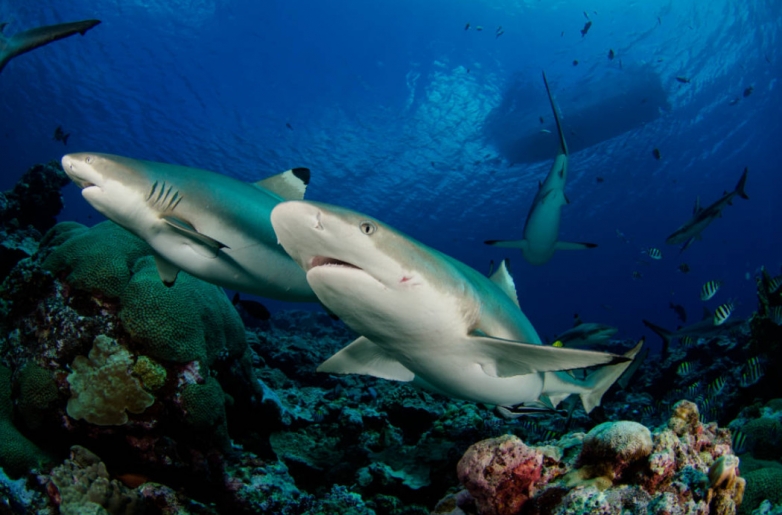
Palau, paradise of sharks — ©Micronesian Shark Foundation
Sharks in an Age of Plague
But there’s a flaw in the sharks’ tourism defense that’s been recently laid bare by what else but the COVID-19 coronavirus. Most of the global tourism fleet is now floating empty, their crews anxiously awaiting the day when the world’s most lethal new predator finally allows their clients out of hiding to swim again in the comforting company of sharks.
“Our operation is suffering financially as there is zero income,” reports Tova Bornovski, who’s been operating the Fish’n Fins dive center in Palau for more than twenty years.
“We are doing the best we can!” writes Susan from Jim Abernethy’s Scuba Adventures, with the Bahama ports still barred to tourists.
Meanwhile, many of the government authorities charged with policing the sanctuary borders find themselves low on funds and stuck on shore, while the pirate fleets of industrial shark poachers come circling.
“We’re seeing this problem everywhere ecotourism exists,” says Ryan Orgera. “If you can’t convince people of the shark’s inherent value, you have to convince them of their economic value. And if you don’t create some form of economic value beyond the value of bodies, it can lead to a scenario where sharks are exploited for fins.”
With the sharks’ defenders held at bay, it would seem the sharks’ looters now hold sway. But there are ways to flip that script. And Demian Chapman may have just hit upon one of them, compliments of the pandemic. Chapman has for twenty years been working in rural fishing villages of Belize. Along with private donations and rotating field crews of Earthwatch volunteers, he’s been employing local shark fishermen to tag and track and video-record live sharks. The fishermen in turn are adopting more scientifically based protocols for making their livings without killing off the fish that feeds them.
“The group as a whole used to land around 30,000 pounds of sharks per year,” writes Chapman. “Now it’s more like 10,000 pounds or less.”
As to the pandemic, Chapman these days is sitting isolated at home in Florida rather than supervising his troops from Belize. And finding his attendance increasingly needless.
“Our solution to the pandemic has been to move away from the in-person stuff and remotely work with collaborators,” he says. “And it is actually accelerating the transfer of technology for local and indigenous people to build the capacity so they can do this stuff without us—eventually entirely without us.”
Eye to Eye
In the science of saving species, where triage has become the rule, all creatures are not created equal. Among the most immediately precious are the keystone species, those whose removal–as the original metaphor goes–brings the roof crashing down. Tops among the ocean’s most likely keystones are the great sharks. They are the ones we will likely miss most dearly. But for reasons far beyond any practical accounting.
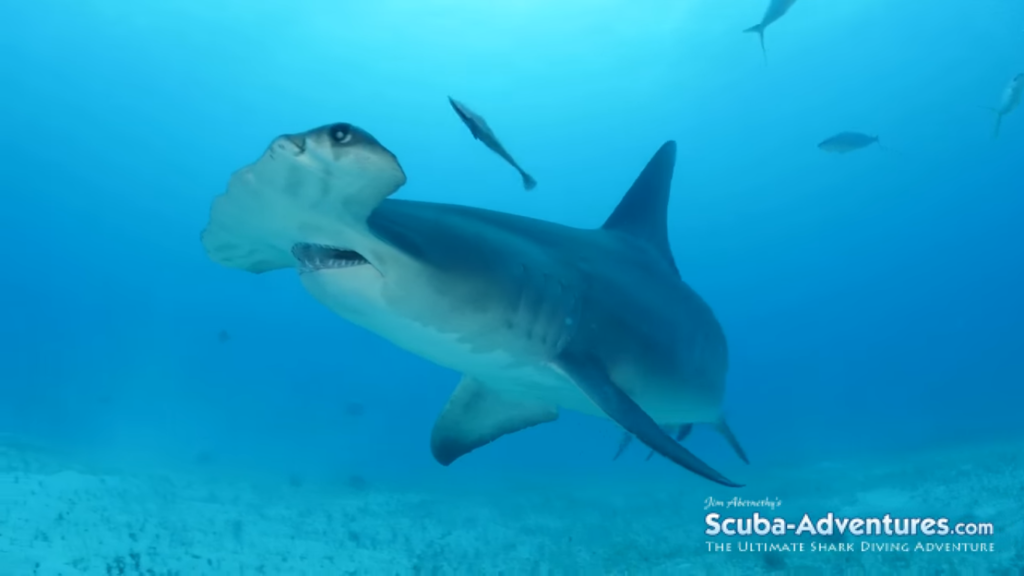
“You can take all these scientific things, like the functional need of them, for economic reasons, for biodiversity,” says Chapman. “You can take all that off the table and still we should protect them. Do we as humans want to be the species that wiped out an animal that’s been around for 400 million years? What a disgusting stain on our species that our blindness and bloodlust would allow us to do that.”
But what if we didn’t allow for that darker side of us? What if our tide of violence has begun to turn?
In 2002, Tova Bornovski and her husband Navot founded the Micronesian Shark Foundation, to study and protect and celebrate Palau’s spectacular kingdom of sharks. These days nearly every 5th grader in Palau gets a visit from Tova and her sidekick, Finny the Funny Shark—who of course tells funny shark jokes, but also leaves the young Palauans with a fresh appreciation for the special place on Earth they inhabit. And they in turn, pass it on.
“In Palau, adults listen to children,” says Tova. “I had a few occasions where an older gentleman tapped my shoulder, telling me he went fishing with his grandson and he wouldn’t let him fish sharks. He winked and said, ‘It’s because of you.’”
Orgera adds, “I have noticed, in my lifetime, a marked change in how we perceive sharks. There’s a sense of sharks in need of our help, that they’re creatures we should marvel at rather than fear. It’s changing rapidly.”
Orgera thinks back to a moment now etched in memory, about five years ago, when he came upon the video of a great white shark on a Massachusetts beach, struggling and stranded behind an outgoing tide.
“All of a sudden—one of the most incredible images—scores of people on the beach are digging a trench and throwing water over its gills. They are trying to get the shark back in the water!”
There is something inherently uplifting about that circle of strangers joining hands on behalf of a big strange fish—a fish who not so long ago was the leading villain of the most iconic monster movie of our time. Those shark Samaritans give hope to those of us who cannot fathom a fate more dreary than a world devoid of humbling giants.
So I have this dream. I am walking once again upon the fishing docks of Key West. But this time, not only are there no big sharks hanging there, there are no fish at all hanging there. Yet the crowds are gathering again like before. Where the gallows once hung there are now widescreen video displays of the day’s “catch,” shot underwater through the GoPros and iPhones of amateurs. And we are all staring up, spellbound, as the looping reel of stills and videos reveals shoal upon swirling shoal of brilliant little fish, parted by monsters—tiger sharks, bull sharks, dwarfing the divers.
And out of the blue comes the unmistakable spaceship prow of the great hammerhead, straight for us. Veering as it passes, its alien eye catches ours. It leaves us all standing transfixed, amid a collective gasp of awe.
For the ever more curious and wannabe shark saviors, here are just a few of my favorite sites among so blessed many:
Fish N’ Fins, Palau
Florida International University Predator Ecology and Conservation Lab
Jim Abernethy’s Scuba-Adventures
Marine Bio.Life
Micronesian Shark Foundation
Sanibel-Captiva Conservation Foundation Shark Program
Save Our Seas Foundation
The Hooper Collective
University of Miami Shark Research
Amazing, I have a very different view of shares now, thanks 😁
Amazing they are. Welcome to the fan club!
Proud to say I’m related to this wonderful writer! As always, wonderful!
The pride goes both ways, cuz. Thanks for tuning in.
Great article! Thank you for adding to the awareness – these animals need our help. I am scheduled to dive with Jim Abernethy this summer and hope the images I collect can help shed more positive light on our friends in the sea.
Thanks Tony. My envies of your dive with Jim this summer. Say hi to Jim and Emma!